Last week I talked about how trigger points in our muscles can cause pain in other areas of the body and how this can trick us. However, muscle trigger points are not the only structures in the body that are known to cause referred pain.
Our internal organs can do the same thing. The most classic example of this is the heart. We all know that chest pain and left arm pain are signs of a heart attack. When the heart is irritated or under stress, it refers pain down the arm. This is a great example of why it's so important to see a doctor who understands referred pain.
Imagine going to the hospital with chest and left arm pain, and the doctor starts treating your left arm. If that happened to you, you're probably not going to have a very good outcome! Even though the pain is in the left arm, the only way to get the pain to go away is to treat the heart which is the source of the pain.
In this blog, I'm going to go over the three most common internal-organ referred pains that I see in patients at my clinic.
The number one most common internal-organ referred pain that I see is for kidneys. This pain referral pattern is most often seen during the formation of a kidney stone, but other problems with the kidneys can cause the same thing.
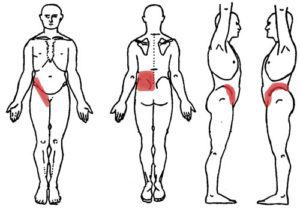
As you can see in the picture above, the kidney can cause pain in the lower back, in the outer hips, and in the front of the hips. The most common presentation is in the low back and specifically the sides of the low back. This is called flank pain.
If you are experiencing pain in these areas, there are a couple of ways to distinguish whether this is just normal back pain or if it might be coming from your kidneys. In regular low back pain, the source of the pain is usually in the muscles, ligaments, and joints of the spine.
Because of the tissues that are irritated in normal low back pain, the pain will normally fluctuate throughout the day, depending on the position of your body and your activities. So the pain might be better at certain times of the days, but get worse when you do certain activities because those tissues are being stressed.
When the pain is coming as referred pain from the kidneys, the pain is usually constant and doesn't change, no matter what you do. If you're having pain like this that is constant, your best bet is to see your primary care doctor instead of a chiropractor or physical therapist.
The second most common internal-organ pain referral that I see in my clinic is the gall bladder. This one can confuse a lot of people. The gall bladder refers pain to lots of different areas of the body and many times in the beginning stages, there's not a lot of hints that the gall bladder is actually having problems.
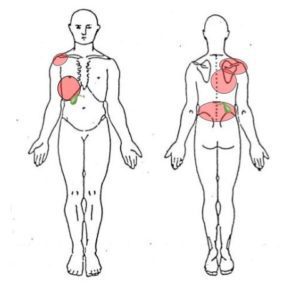
As you can see in the picture above, the gall bladder sometimes can cause pain in the lower right rib cage which is right where the gall bladder is. However, a lot of times, it is known to refer pain to the top in the back of the right shoulder, and less commonly the low back.
There are a couple of clues that you can look for to see if your pain in these areas might be coming from your gall bladder. The best clue is if you notice this pain more after you eat, especially after you eat things that are high in fat content, as this is when the gall bladder goes to work to help digest the fat. The other clue you can look for is in your stool. When the gallbladder is not functioning properly, the food that we eat will not be properly digested and absorbed, and it will come out in your stool. If you notice after you go to the bathroom that your stool is either floating on the surface of the water or sticks to the side of the bowl ,this can indicate that your body is not properly digesting fat and that the gall bladder is in trouble. These clues would tip you off that you need to see your primary care physician instead of a physical therapist or a chiropractor.
The final most common internal-organ referred pain that I see in my clinic is from the stomach and intestines. Oftentimes, our GI system doesn't present with very obvious symptoms when it's under stress. Therefore, many times the first symptoms that a patient notices is the pain referral.
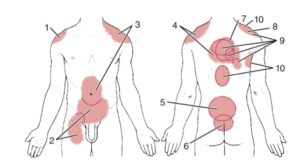
As you can see in the picture above, the stomach and intestines can refer pain to many different areas. The most common area that many people already understand is that if they feel pain in their abdomen, they most likely have something going on in their stomach or intestines.
What I see a lot in my clinic is pain in the low back being caused by the stomach or intestines. This can actually happen for multiple reasons. Sometimes the actual structures in the stomach or intestines can refer pain to the back, but another common thing that happens is when your stomach or intestines are irritated, they will actually send signals to the brain to decrease the activation in your core muscles so that the muscles do not press hard against the internal organs. This reduction in core muscle activity can also lead to low back pain.
*Note: If you are suffering from low back pain, one of the best tips that I give people to determine whether this might be coming from the stomach or intestines is simply to pay attention to the sensations in their abdomen. You should not feel your stomach and intestines during normal digestion.
Sadly, in America, many of our diets are very poor and we eat lots of inflammatory foods. So it might be very common for you to feel a burning or irritation after you eat - but this is not normal. If you are experiencing low back pain, and you commonly notice that after you eat you feel like a burning sensation or a discomfort in your belly this is a big sign that your low back pain may be coming from the stomach or intestines. Your first stop should be your primary care physician.
Unlike some of the other organs mentioned above, referred pain in your stomach and intestines may require a trip to your chiropractor or physical therapist after you've seen your primary care doctor.
If your pain was coming from the inactivity in the core muscles that I mentioned earlier, you may require some core activation exercises to help return your body to normal and decrease your low back pain.
So there you have it. Our body can be very tricky! And understanding referred pain is the best way to shorten the amount of time it takes you to get better. Like I was saying above, if you're having chest pain and left arm pain and your doctor wastes time treating your left arm first, it's going to take you longer to get better. So make sure you see a doctor who is knowledgeable on referred pain.
If you're in the Tulsa area and are experiencing pain that you think might be referred pain, give us a call at 918-300-4084. Dr. John Keefe can do a thorough exam and let you know if his care would be right for you or if you should go see your primary care doctor.

Well - Halloween is fast approaching! As I was thinking about trick-or-treating, it made me think about the tricks that our body can play on us. So, for the month of October, I'm going to be covering the different ways that our body can trick us.
This week we're going to be talking about trigger points. You may have never heard of trigger points before, but you probably have felt them! When our muscles contract, the entire muscle does not contract all at once. If you start with your elbow straight and slowly bend your elbow, your bicep is one of the main muscles that does this action.
However, when you start to bend your elbow, the entire bicep muscle does not contract all at once. At first, the part of the bicep that's closest to your elbow is the only part that contracts, then slowly the middle portion of the bicep will contract, and then when your fist is up next to your shoulder, the upper portion of the bicep will be contracting.
This is how our muscles are supposed to work: Different sections contract depending on what our body is doing at that time - and then they relax when we stop moving that body part. At least that's how it's supposed to work. Sometimes little sections of our muscles will stay contracted even after we've stopped using that muscle. This tiny little section of muscle that remains in a contracted state is usually kind of hard to the touch. If you've ever felt a knot in a muscle, you're feeling a trigger point.
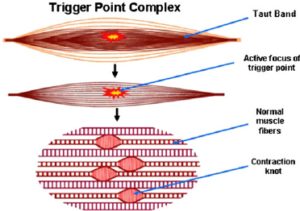
In this blog, I'm going to mention the different types of trigger points, trigger point pain referrals, and the three most common trigger point referrals I see in my patients that try to trick us about where the pain actually is.
There are two types of trigger points:
1) Active trigger points
2) Latent trigger points
If you're walking around and you feel a painful area in a muscle, that is an active trigger point. That means that it's painful at rest. But if you've ever had a massage, and when the massage therapist starts pressing on an area, you find that it's super tender and very painful, but it wasn't painful until they touched it, that is what's called a latent trigger point.
Trigger points are known to produce what is called referred pain. If you have ever heard of the symptoms of a heart attack, specifically the pain down the left arm, this is another example of referred pain. Referred pain is when one specific structure is irritated, but we actually feel the pain in other areas.
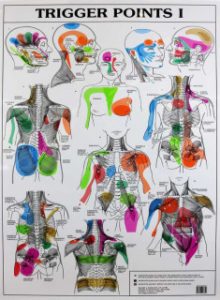
This can be extremely confusing, but it's very important to know if your pain is referred or not. Imagine if you went to the hospital with chest pain and left arm pain, and the nurses just started treating your left arm. You probably wouldn't have a very good outcome.
This is why it's important that your doctor is familiar with the concept of referred pain.
Otherwise valuable treatment time may be wasted on areas that are not actually irritated, but are just the location of referred pain.
The woman who first discovered trigger points created maps of trigger point referral patterns. These maps showed the areas where referred pain is felt for all the different trigger points in all of the muscles of the body.
The three most common trigger point referrals that I see in my practice are:
The gluteus medius muscles are located on the side of both hips. Trigger points in these muscles can send pain down the side and back of the thigh all the way to the back of the knee. Some doctors have called these trigger point referrals pseudo sciatica. Many people with trigger points in these muscles will actually think that they're having sciatica pain/issues, but really, it's just a trigger point.

Above you will see the trigger point referral map for the gluteus medius. It can cause pain around the low back or SI joint and all the way down the thigh to the knee. If you are having pain in these areas, I recommend you get assessed by a doctor who's familiar with trigger points.
__________________________
The infraspinatus muscle is on the back of the shoulder. However, the trigger point referral actually wraps around to the front of the shoulder. Sadly, I have seen patients who had surgery on the front of their shoulder - and their pain didn't change at all. It was only after treatment to the infraspinatus on the back of the shoulder that their pain went away.
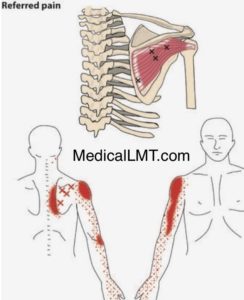
Above you'll see the trigger point referral map for the infraspinatus. It can cause pain along the inner shoulder blade area, the front of the shoulder, and down the bicep. If you've had pain in these areas and maybe even have had some treatment with no help, make sure to see a doctor who's familiar with trigger points.
_________________________
And finally, there is the thoracic erector spinae. The erector spinae muscles are the muscles that run up the spine very close to the bones of the spine. These are the muscles that help us stand up tall. In the thoracic region or mid-back, trigger points in these muscles can actually refer pain to the low back and tailbone. I will often see patients who complain of low back pain and have had lots of adjustments to the low back and pelvis with no improvement. Once we treat the erector spinae, their pain goes away.
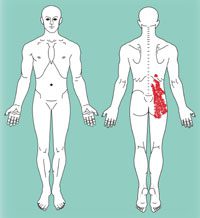
Above, you can see the trigger point referral map for the thoracic erector spinae. Interestingly, you can see that the pain referral map is almost completely in the low back. Meaning: You might not have any pain in your mid back, but that's actually where your problem is. These muscles can refer pain down to your low back tailbone and even the back of your hip. If this is a problem area for you - again - please make sure to see a doctor who's familiar with trigger points.
So there you have it, our body can really try to throw us for a loop. This is why it's always good, when you're in pain, to get a proper evaluation by a doctor who will look at all areas of the body and not just where you're hurting. This is something we do with every patient here at Movement Laboratory. If you're hurting and you suspect that you might have some referred pain going on or any other type of pain, give us a call at 918-300-4084 and we'll help you get out of pain fast!
Tune in next week when I'll discuss how some of our internal organs can cause pain all across our body!
